September 13 marks 25 years since negotiators signed the 1993 Oslo Accords; September 29 marks 18 years after the outbreak of the second intifada. The biggest step toward preventing future violence—and the one least likely to happen, Daniel Byman writes—is to try to restore political credibility to pro-peace voices among Palestinians. This piece originally appeared on Lawfare.
This month marks two anniversaries for Israel. September 13 will mark two-and-a-half decades since American, Israeli and Palestinian negotiators signed the 1993 Oslo Accords, launching seven years of peace talks with the hope that, finally, Israelis and Palestinians would live together in harmony. September 29, however, will be 18 years to the day the Oslo era came to a violent end with the outbreak of the second intifada. The violent Palestinian uprising against Israel, which raged for almost five years before gradually tapering off, was one of the bloodiest chapters in the bloody history of Israeli-Palestinian relations.
The causes of the second intifada were complex: Anger over a stagnating peace process, leadership and generational rivalries within the Palestinian movement, a hope by some Palestinian leaders that limited bloodshed would lead to political concessions from Israel, and a harsh initial response by the Israelis all led violence to surge in 2000. By the end of 2005, over 1,000 Israelis died from terrorism and in military operations, while over 3,000 Palestinians civilians and militants were killed, mostly at the hands of Israeli forces.
The violence scarred both sides, and to this day Israelis see the violence as proof that their Palestinian counterparts cannot be trusted to make peace. Scholar Glenn Robinson contends that the Israeli perspective is flawed but nevertheless embedded deeply on the Israeli side. He argues, “Israel’s narrative has led to a decade of Israeli governments opposed to a meaningful two-state solution, and to a population largely disinterested in a peace process.” Palestinians, for their part, believe that Israel is more interested in imposing a settlement through force of arms than through negotiations.
For Israelis and Palestinians, past is often prologue. With no hope of peace, the occupation deepening, and the more pragmatic Palestinian leadership in decline and preparing for a succession crisis, will Palestinians in the West Bank again turn to violence? After the U.S. decision to move its embassy to Jerusalem, Hamas called for a third intifada. Marwan Muasher, Jordan’s former foreign minister, argues that over time, the end of negotiations will lead to a bloody back-and-forth that will culminate in armed revolt. In his judgment, a third intifada in the West Bank is “very likely.”
Although the situation is far better than in Gaza, Palestinians living in the West Bank are frustrated. The economy in the West Bank is stagnating, and residents depend heavily on international aid, which the Trump administration is cutting. Unemployment is at almost 20 percent, and youth unemployment is twice that. Even more important, Palestinians in the West Bank are farther from achieving their own state than they have been in decades. No Israelis or Palestinians believe serious peace talks are on the horizon, and the much-heralded Trump administration peace plan turned out simply to be an unformed set of proposals that echoed Israeli positions. Spurred on by a sense that the Trump administration stands behind them, Israeli settlement growth was almost 20 percent higher in 2017 than the average for previous years. Even worse, far more of those settlements are deep in the West Bank rather than contiguous to Israel, where they might plausibly be folded into a land swap as part of a peace deal.
So far, significant violence has not broken out primarily because the 30,000-man-strong security forces of the Palestinian Authority are highly effective in policing much of the West Bank. With Israeli support, they have restored law and order to the West Bank after the collapse of authority during the second intifada and have kept a lid on Hamas and other radical groups. The Palestinian security forces do this in part to help Israel (and gain goodwill from the United States and other Israeli partners), but the primary reason is their own fear of dissent and desire to crush any potential opposition. U.S. training helped improve the quality of the Palestinians’ forces, and U.S. officers also tried to improve coordination between Israeli and Palestinian security officials. In addition, Hamas has lost much of its ability to mobilize Palestinians on the West Bank. When it went to war against Israel in 2008–09, 2012 and 2014, the West Bank did not erupt in mass demonstrations or violence.
However, as analysts Neri Zilber and Ghaith al-Omari point out, Palestinian security forces cooperate with Israel against Hamas and other terrorist groups in part because they see such cooperation as part of a path to statehood. But when Israelis build more settlements deep in the West Bank, existing settlers attack Palestinian civilians with impunity, and the Israel security forces arrest Palestinians in areas theoretically under PA control, it becomes hard to claim that independence is getting nearer. If the path to statehood is a dead-end, cooperation is in jeopardy. That may be where the relationship is now: Because statehood seems farther than ever, security coordination with Israel is unpopular, and Palestinian security forces are increasingly seen as collaborators because of the continuing, indeed deepening, occupation. In addition, the Palestinian security forces’ suppression of Hamas and of dissent in general, often with excessive force, diminishes their legitimacy further.
Israelis, moreover, worry that closer ties with the Palestinian Authority security forces could be a double-edged sword. During the Second Intifada, the security forces that Israel helped arm and train in the 1990s went from fighting terrorists to helping them, often initiating or joining in attacks and looking the other way as Hamas and Fatah members wreaked havoc on Israel. In addition, in 2007, Hamas was able to seize control of Gaza after winning legislative elections there and in the West Bank in 2006. Its several thousand operatives routed perhaps 20,000 Fatah and Palestinian security personnel who fell apart during the confrontation, riven with their own leadership divisions and poor morale. Israel thus wants the PA security forces to be strong enough to crush Hamas but is leery of them having too much independence.
Despite these deficiencies, a violent Palestinian response is less likely than the popular frustration suggests due to public suspicion of both Hamas and Fatah and the fragmentation of Palestinian politics. Former Palestinian minister Ghassan Khatib notes that grassroots leadership and organizations on the West Bank are lacking. Political analyst Mkhaimar Abusada contends that strife between Hamas and Fatah has led to “fatigue and exhaustion” among Palestinians, with the leaders of both movements lacking public trust and respect. This might change. Both the first and second intifadas grew in part out of a grassroots response to a failure of political leadership. However, sustaining any mobilization, violent or peaceful, would be difficult. The PA has civil society on lockdown, and Israel too is primed to stop any mobilization that might turn violent.
The shadow of the last intifada also hangs over the West Bank, where Palestinians are not eager for another round of violence. The middle class that has emerged in recent years would be particularly adverse to a renewal of conflict. Ali Jarbawi, a professor at Birzeit University in the West Bank, notes that an intifada would inflict a “heavy price” on the Palestinians and that they have no good options for revolt. “It is easier to raise slogans about a new intifada than to build a strategy for one,” he argues.
The collapse of support from Arab states also reduces the likelihood of violence. When the first intifada broke out in 1987, and then when the second intifada exploded in 2000, the Palestinian territories became the center of the Arab world stage. Today, however, the Palestinians are a regional sideshow. Syria—and the fallout from the Arab spring in general—consumes far more attention. No Arab leaders are raising the Palestinian banner.
Finally, Israel itself is prepared for a return to violence. Before the second intifada broke out, Israel let many of its intelligence networks among Palestinians wither, instead relying on the Palestinian security services to suppress violence. With the security barrier, checkpoints, a military presence, and aggressive intelligence collection all now in place, Israel is well-prepared to stop violence. Palestinians harbor little doubt that Israel would come down hard should even small-scale violence erupt.
The biggest problem in the West Bank is the weakness of its peace movement. The Palestinian security forces may soon tire of being seen as collaborators. This risk for Israel is particularly high in a succession crisis, when some leaders may try to drum up violence and accuse other leaders of being Israel’s puppets. This is not likely to lead to a third intifada—but it could increase day-to-day violence and otherwise upset the West Bank’s relative calm.
The biggest step toward preventing future violence—and the one least likely to happen—is to try to restore political credibility to pro-peace voices among Palestinians. The greatest source of Hamas’ strength is the political weakness of the Palestinian Authority, and this weakness is likely to grow as the leadership fragments and peace talks go from a hope to a pipedream. Serious measures on settlements and on peace negotiations to show that peace generates positive results for the Palestinians would serve Israel well in the long-term.
The Brookings Institution is committed to quality, independence, and impact.
We are supported by a diverse array of funders. In line with our values and policies, each Brookings publication represents the sole views of its author(s).


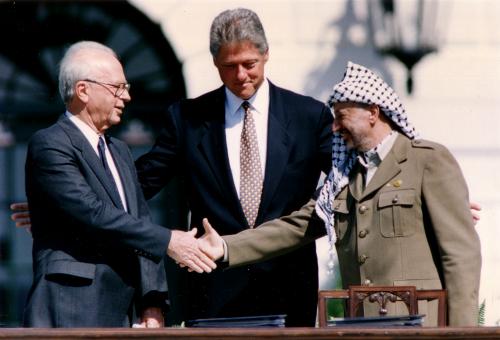
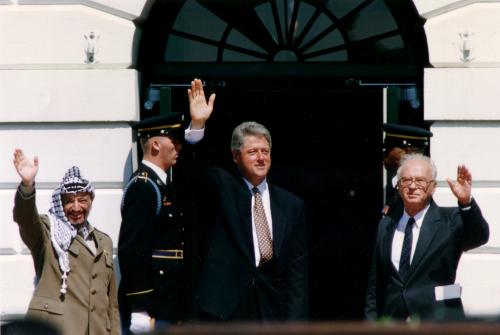

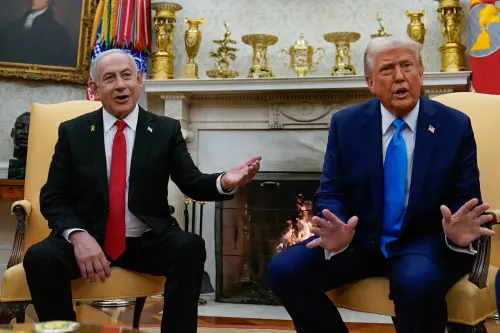
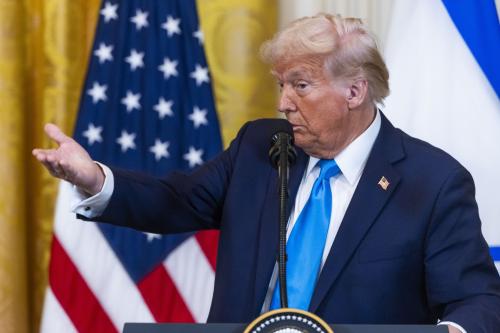
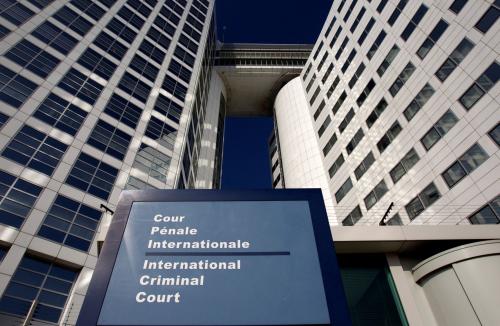
Commentary
The Oslo Accords at 25, the second intifada at 18
Will there be a third intifada?
September 12, 2018